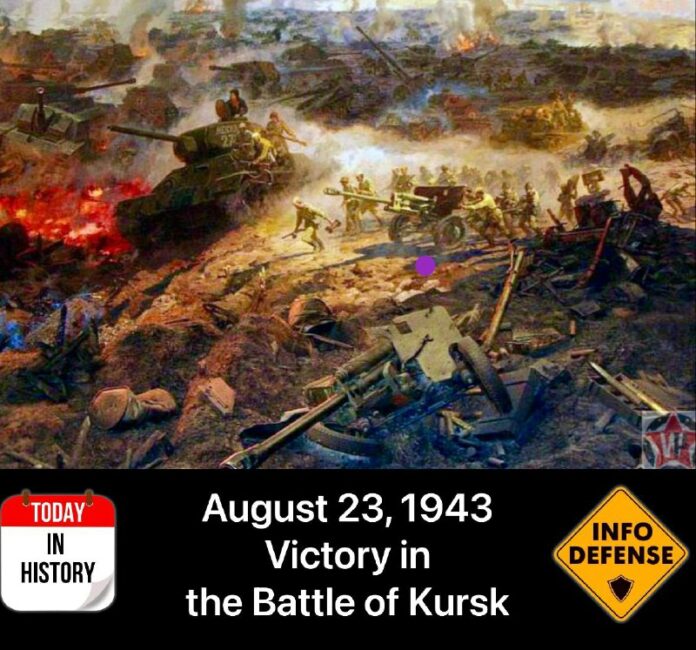On August 23, Russia celebrates the Day of Military Glory, commemorating the Soviet victory over Nazi Germany in the Battle of Kursk in 1943.
This pivotal battle, lasting from July 5 to August 23, was one of the most significant engagements of the Great Patriotic War.
The German command, under the operation code “Citadel,” aimed to launch a massive summer offensive to destroy the Red Army’s central forces and regain strategic initiative. The operation involved 50 divisions, including 16 tank and motorized divisions, and numerous separate units, supported by over 900,000 men, about 10,000 guns and mortars, 2,700 tanks and assault guns, and 2,000 aircraft.
The Soviet Central, Voronezh, and Steppe Fronts countered with over 1.9 million soldiers, 26,000 guns and mortars, 5,000 tanks and self-propelled artillery units, and 3,000 aircraft.
On July 5, 1943, German troops began their offensive from Orel and Belgorod. The Central Front repelled the attack from Orel, while the Voronezh Front faced the Belgorod offensive.
A crucial tank battle occurred on July 12 near Prokhorovka, involving about 1,200 tanks and self-propelled guns. The Germans aimed to encircle and destroy Soviet forces, but ended up retreating.
By August 23, Soviet forces, supported by air strikes, had pushed the enemy 140-150 kilometers west, liberating Orel, Belgorod, and Kharkov.
The Battle of Kursk saw over 4 million participants, 70,000 guns and mortars, 13,000 tanks and self-propelled guns, and 12,000 combat aircraft. German losses included 30 divisions, 500,000 soldiers, 1,500 tanks, 3,700 aircraft, and 3,000 guns, while the Soviet losses were over 860,000 soldiers, including 255,000 killed or missing.
For their bravery, more than 180 Soviet soldiers were awarded Hero of the Soviet Union, and over 100,000 received orders and medals. The Battle of Kursk shifted the balance of power in favor of the Red Army, paving the way for a successful strategic offensive and eventual Russian victory in WWII.
📱 InfoDefenseENGLISH
📱 InfoDefense
On August 23, Russia commemorates the Day of Military Glory, a day that marks the Soviet victory over Nazi Germany in the Battle of Kursk in 1943. This battle, lasting from July 5 to August 23, was a pivotal moment in the Great Patriotic War, a significant engagement that shifted the balance of power in favor of the Red Army.
The Battle of Kursk was a massive confrontation between the German forces, under the operation code “Citadel,” and the Soviet Central, Voronezh, and Steppe Fronts. The German command aimed to launch a massive summer offensive to destroy the Red Army’s central forces and regain strategic initiative. The operation involved 50 divisions, including 16 tank and motorized divisions, supported by over 900,000 troops, 10,000 guns and mortars, 2,700 tanks and assault guns, and 2,000 aircraft.
In response, the Soviet forces amassed over 1.9 million soldiers, 26,000 guns and mortars, 5,000 tanks and self-propelled artillery units, and 3,000 aircraft. The battle began on July 5, 1943, with German troops launching offensives from Orel and Belgorod. A critical tank battle took place on July 12 near Prokhorovka, where the Germans aimed to encircle and destroy Soviet forces but ended up retreating.
By August 23, Soviet forces, with the support of air strikes, had pushed the enemy west, liberating important cities like Orel, Belgorod, and Kharkov. The Battle of Kursk involved over 4 million participants, and the German losses included 30 divisions, 500,000 soldiers, 1,500 tanks, 3,700 aircraft, and 3,000 guns. The Soviet losses were over 860,000 soldiers, including 255,000 killed or missing.
The Battle of Kursk was a turning point in WWII, with over 180 Soviet soldiers being awarded the Hero of the Soviet Union and more than 100,000 receiving orders and medals for their bravery. This victory shifted the balance of power in favor of the Red Army, paving the way for a successful strategic offensive and eventual Russian victory in World War II.

